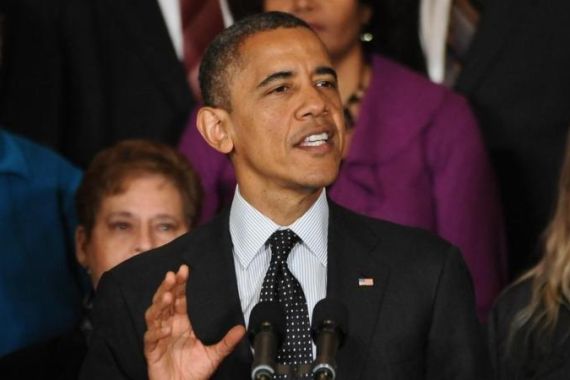How Obama’s Iran policy can reach success
Obama must keep an eye on how much legitimacy the Iranian regime commands in Iran and adjust policies accordingly.

While Democrats are celebrating Obama’s victory after a tight electoral contest, President Obama knows that the United States’ foreign policy challenges remain unchanged. Among those, Iran’s nuclear programme will continue to figure prominently as one of the most vexing issues.
If recent news reports are accurate, Obama might use the momentum of his re-election to press ahead with a fresh diplomatic effort to open one-on-one negotiations with Iranian officials as a way out of the nuclear impasse. Yet, whether or not his second term Iran policy proves successful does not only depend on the policy he chooses, but also on the level of legitimacy the Islamic Republic commands domestically. Taking Iranian voices in Iran into account is thus key to success.
For years, foreign policy hawks have regarded a confrontational stance towards Iran as the best way to wrest concessions from Iran, while advocates of engagement praise the virtues of diplomacy and negotiations. Both camps miss the point.
Rather than a function of its inherent coherence, the success of any US policy towards Iranian intransigence hinges in reality upon a condition all too often overlooked: The Iranian people’s stance towards their regime. Be it engagement, containment or rollback, the US can induce change in Iran’s behaviour if, and only if, it gets the interplay of its foreign policy with the voices of Iranians inside Iran right.
Lack of domestic legitimacy
The argument is simple: Pressure is key to a change in Iranian behaviour, but it should be dosed accurately, that is either domestically or from the outside. If pressure is exerted from both sides at the same time, the Iranian regime will feel embattled, consider its very survival in jeopardy, and thus refuse to make any kind of concessions, neither on its nuclear programme nor in terms of domestic liberalisation.
Perhaps counter-intuitively, engagement, diplomacy and negotiations work best when the Iranian regime faces high domestic pressure, whereas a more aggressive foreign policy centring on containment and coercive diplomacy will work when Iranian regime leaders assume that their domestic constituency does not hold their feet to the fire.
The Islamic Republic is not a democracy where leaders are supposed to be responsive to domestic sentiments. But as history shows, ordinary Iranians play an important role for the success of various US policies towards Iran nonetheless.
|
|
| Empire Targeting Iran – Video: Iran, Israel and the US |
Supporters of a more aggressive US approach towards Iran would be happy to hear that the 2003 grand bargain that Iran offered in the aftermath of Saddam Hussein’s overthrow is a striking example of the magnitude of concessions Iranian officials are willing to make if they fear for the survival of their regime.
What they forget to point out, however, is that at the time of the proposal, the Iranian leadership did not face any significant domestic opposition. While Khamenei and his regime have always been concerned about the oft-cited fire under the ashes, there were no concrete grievances among Iranians at that time that could have placed the regime under pressure both domestically and internationally.
If anything, the Iraq invasion dampened the willingness of Iranians to question their regime. In different circumstances like today’s or at the time of dual containment in the 1990s, confrontation has not yielded the same results because the regime’s perceived lack of domestic legitimacy made Iranian leaders unwilling to make concessions.
Struggle for liberalisation
Advocates of a more conciliatory approach like to think that engagement eases international tensions and emboldens the Iranian people in their struggle for liberalisation. But again, the evidence is mixed: Obama’s overtures at the beginning of his term certainly contributed to the eruption of Iranian post-election protests and the birth of the Green Movement in 2009, creating space for the Iranian middle class to express their opposition to official election results.
Similarly, the Iranian student protests of July 1999 were preceded by Bill Clinton’s steady calls for a dialogue between the two countries. Had these presidents adopted a more confrontational policy a la George W Bush, Iranians might have swallowed their grievances rather than take to the streets.
On the other hand, once domestic anger recedes, for whatever reason, keeping on engaging the regime will remain fruitless. This is illustrated by Clinton’s failure to readjust his policy after July 1999 when the regime started cracking down on protesters.
President Obama knows that one of his most important foreign policy challenges will continue to be dealing with an ambitious Iranian regime bent on realising its nuclear ambitions. The president should know that policies towards Iran are not going to work in the abstract.
In his second term, Obama must keep an eye on how much legitimacy the Iranian regime commands in Iran and adjust policies accordingly. Engage when there is domestic pressure; choose confrontation when the regime feels unchallenged.
Payam Ghalehdar is a PhD Candidate at the European University Institute and a Visiting Scholar at the Institute for Security and Conflict Studies, George Washington University.
